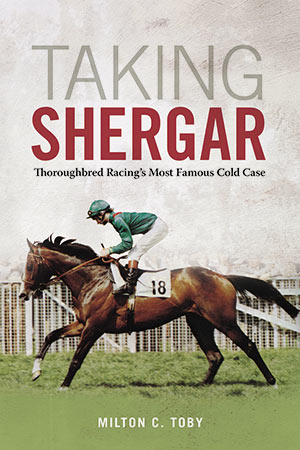TAKING SHERGAR: thoroughbred racing’s most famous cold case
Published in Book Reviews, Book Reviews, Issue 5 (September/October 2019), Volume 27MILTON C. TOBY
University Press of Kentucky
$29.95
ISBN 9780813176239
Reviewed by
Dean Jobb
Dean Jobb is the author of Empire of deception and teaches non-fiction writing at the University of King’s College, Halifax, Nova Scotia.
 On a bitterly cold night in February 1983, a band of armed and masked men descended on a stud farm in Ballymany, Co. Kildare. After coaxing one of the thoroughbreds into a trailer, they disappeared into the darkness. It was the last time that Shergar—winner of the prestigious Epsom Derby and the most famous and valuable horse in Ireland—was seen alive. One horse-breeder likened it to the theft of a painting as priceless as the Mona Lisa.
On a bitterly cold night in February 1983, a band of armed and masked men descended on a stud farm in Ballymany, Co. Kildare. After coaxing one of the thoroughbreds into a trailer, they disappeared into the darkness. It was the last time that Shergar—winner of the prestigious Epsom Derby and the most famous and valuable horse in Ireland—was seen alive. One horse-breeder likened it to the theft of a painting as priceless as the Mona Lisa.
A ransom of £2 million was demanded but never paid. The Gardaí and volunteer searchers scoured the countryside but turned up no trace of the men, the trailer or the horse. True to the subtitle of Taking Shergar, American writer Milton C. Toby’s new book on the brazen theft, it remains the most famous cold case in the history of thoroughbred racing. There were, however, some logical suspects: members of the provisional wing of the Irish Republican Army.
Toby, a lawyer and the author of a shelf of books on horseracing, builds a strong circumstantial case for IRA involvement. ‘The number of people and vehicles involved, the magnitude of the heist, and the obvious planning,’ he writes, ‘suggested a paramilitary operation.’ The timing was telling. Law enforcement efforts had disrupted the supply of weapons and money from the United States and the IRA had resorted to kidnappings and robberies to fund its operations, but attempts to hold wealthy businessmen for ransom had been foiled or ended with the hostages freed and the kidnappers in custody. Shergar, a horse worth a fortune as the sire of future race-winners and stabled at an unguarded farm, was a tempting target.
Toby tracked down and interviewed the aging men connected with the case, including an adjuster who monitored the search for Lloyd’s of London, which had insured the horse. The case made international headlines, giving him plenty of material from media accounts as events unfolded. Psychics and ‘remote viewers’ were imported from America, he discovered, in a last-ditch effort to locate the horse. But Toby faced a major roadblock in his pursuit of the truth: the Garda files on the investigation are still closed, so the official list of suspects remains a mystery.
The best evidence available suggests that Shergar was injured when he was seized or shortly afterwards, forcing his abductors to put him down within a few days. A decade after the horse was taken, a key IRA member-turned-informer, Seán O’Callaghan, confirmed the organisation’s involvement and even named five members of the team that made off with the horse. Toby cautions, however, that O’Callaghan was ‘a confessed informer whose life depended on his ability to weave a convincing web of lies’, and he was only relating what others had told him.
In a final twist, the IRA, which rarely passed up a chance to tout its efforts to end British rule in Northern Ireland, never claimed responsibility for the theft. Toby argues that this was probably because the organisation ‘feared a backlash from the horse-loving Irish’ when ‘a simple ransom scheme turned into a disaster’. Shergar’s disappearance became more than a potential public relations disaster for the IRA—police stumbled upon a number of safe houses and seized caches of weapons during the search for the horse and his captors.
Toby lives in Kentucky, the heartland of horse-breeding in America, and has been writing about the sport for four decades. It’s not surprising, therefore, that he devotes a substantial portion of the book to the lineage and accomplishments of a horse that is considered among the greatest thoroughbreds in history. There is also plenty of background material on the Aga Khan IV, the Muslim spiritual leader and multimillionaire who headed the syndicate that owned and bred the horse.
This focus on horse and owner delays Toby’s recreation of the abduction—the most dramatic episode in the story—until the mid-point of his narrative. Gun-toting thugs burst into the home of Shergar’s groom, James Fitzgerald, and held his family hostage while the horse was taken. Then they abducted Fitzgerald as well, before releasing him on a country road with a warning not to call the police. The groom was so traumatised that it was hours before the Gardaí were notified, allowing the culprits plenty of time to escape.
Toby explores other theories about the abduction but he’s convinced that the IRA was responsible, even though he admits that the surviving evidence is inconclusive. Taking Shergar may not crack this cold case but it could well be the last word on a horse-napping gone wrong.
















